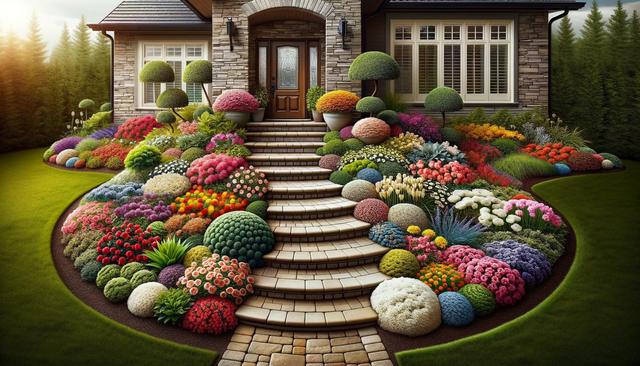
A Guide to Subtle Flower Bed Ideas That Make Front Yards Stand Out
Embracing Natural Borders for Gentle Definition
One of the most effective ways to create subtle flower beds in your front yard is by using natural borders. Instead of rigid, geometric outlines, consider edging your flower beds with organic materials like river stones, small hedges, or low-growing ground covers. These options provide definition without drawing too much attention, allowing the plants themselves to be the focal point. Natural borders blend seamlessly with surrounding landscapes, especially when their textures and tones complement the nearby hardscaping or lawn.
To keep the look refined, choose plants that naturally stay within their boundaries or are easy to trim. Some excellent choices include:
- Lamb’s ear for a soft, silvery edge
- Boxwood for a clean, evergreen appearance
- Thyme or creeping Jenny for a slightly cascading effect over rocks
By focusing on low-maintenance yet visually appealing borders, you can frame your flower beds without overwhelming the yard’s overall aesthetic. This approach works well for both traditional and modern homes, making it a versatile strategy for enhancing curb appeal.
Layering Plants for a Soft, Textured Look
Layering is a simple yet powerful technique that adds depth and texture to flower beds. Rather than planting a single row of blooms, mix different heights and forms to create a gentle flow that draws the eye. Start with taller plants in the back and gradually work toward shorter varieties in the front. This arrangement not only improves visual interest but also helps each plant get enough sunlight and space to thrive.
For a cohesive look, stick to a limited color palette and repeat similar plant shapes or hues throughout the bed. Some effective plant combinations might include:
- Delphiniums or ornamental grasses in the back
- Lavender or coneflowers in the middle
- Pansies or alyssum along the front edge
Using varying foliage textures—like the feathery fronds of ferns against the broad leaves of hostas—can add another subtle layer of interest. Thoughtful plant layering creates a tranquil, garden-like feel that enhances the welcoming nature of your front yard.
Color Schemes That Complement Rather Than Compete
Color plays a key role in achieving a subtle yet striking flower bed design. Instead of bold, contrasting combinations, opt for a more harmonious palette that enhances the existing tones of your home’s exterior. Neutral and pastel shades tend to blend well into the landscape and offer a calming effect without being dull.
Try focusing on one of the following color themes:
- Monochromatic: Varying shades of a single color, like different purples or whites
- Analogous: Nearby colors on the color wheel, such as blues and purples
- Soft contrast: Light yellow paired with pale lavender or blush pink
Incorporating a few evergreens or silver-leaved plants can help tie everything together and provide structure year-round. Avoid overcrowding your beds with too many vibrant colors, which can make the space feel chaotic. Instead, allow the colors to evolve gently with the seasons, creating subtle shifts that keep the landscape interesting without being overpowering.
Using Perennials for Year-Round Appeal
Perennials are a smart choice for low-key flower beds, offering reliable blooms and structure across seasons. Once established, many perennials require less maintenance than annuals and can return year after year with minimal intervention. They’re ideal for homeowners who want an elegant look without constant replanting or upkeep.
Some perennials to consider for subtle flower beds include:
- Heuchera for foliage color throughout the year
- Salvia for soft spikes of purple or blue
- Daylilies for seasonal blooms with graceful leaves
Mix in a few ornamental grasses or evergreen shrubs to maintain visual interest even in the colder months. The key is to select plants that not only look good individually but also contribute to the overall flow and cohesion of the flower bed. By planning for year-round structure, your front yard will maintain its charm in every season.
Incorporating Hardscape Elements with Subtlety
Integrating hardscape features into flower beds can enhance the overall design without overpowering it. Consider small stone pathways, rustic trellises, or understated garden sculptures that complement rather than dominate the space. These elements can serve both functional and decorative purposes, helping to guide the eye or provide support for climbing plants.
When choosing hardscape materials, aim for natural tones and textures that harmonize with the surrounding plants and home exterior. For example:
- Weathered wood for a cottage-style charm
- Natural stone for a neutral, earthy accent
- Wrought iron for a touch of elegance without visual bulk
Spacing is also crucial. Avoid cluttering the flower bed with too many features. Instead, select one or two focal points and place them strategically, allowing the plants to serve as the main attraction. A well-placed bench or birdbath, for instance, can add interest without detracting from the overall subtlety of the design.
Conclusion: Creating Subtle Impact with Thoughtful Design
A well-designed flower bed doesn’t need to be bold to make a statement. Through the use of natural borders, layered planting, harmonious colors, reliable perennials, and understated hardscape elements, you can create a front yard that feels both refined and welcoming. These subtle touches work together to enhance curb appeal while respecting the existing landscape and architecture. Whether you’re updating your yard for aesthetic pleasure or preparing to sell your home, these gentle design strategies offer lasting impact with minimal intrusion.


